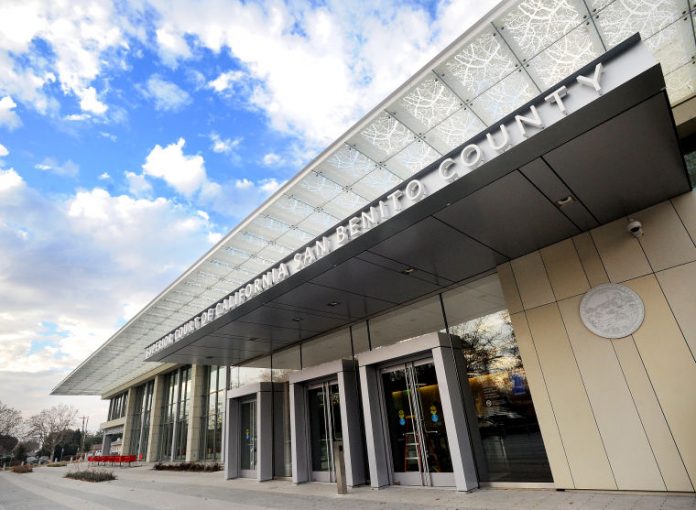
On a recent afternoon, San Benito County Superior Court Judge Steven Sanders gave the Free Lance a tour of the brand-new courthouse, slated for completion in the coming weeks.
Construction started in the spring of 2012 on the $33 million facility along Fourth Street. It will replace the old courthouse across the street from the new one. The old courthouse was built in 1961, Sanders noted.
“It is inadequate for operations,” Sanders said.
He said that once the new building is completed, the court will bring over clerks and employees at the old courthouse to start training on the new, state-of-the-art computer systems.
“This has been a 10-year-plus process,” he said. He said he and other judges and court officials have been considering a new courthouse since the late 1990s.
When the State of California took over the court system in the early 2000s, the superior courthouse – which has only two courtrooms and no holding facilities for inmates – was at the top of the list of courthouses to renovate.
The county and state had considered building the new courthouse at a facility on Flynn Road, but the idea was eventually nixed when local leaders pushed for a downtown site.
“The desire was to have a courthouse downtown,” he said.
He said he was eventually able to secure commitments from the city to provide land for the courthouse. The city, working with the county, secured a land swap for the new grounds at the new spot on the corner, the former site of Fremont School.
“It is adequate to carry us for the next 50, 100 years,” Sanders said.
The new facility is roughly 42,000 square feet. It contains three courtrooms, one for criminal and two for civil cases, and a jury deliberating room that will eventually be converted into another courtroom. The entire building is retrofitted with energy-saving materials and cost-saving measures.
“We’ll have one of the highest awards for efficiency,” he said.
The contractor who designed the building, Kitchell Construction, recently won an architect’s award for the building’s design, Sanders said.
The judge and other court officials had sat with the planners and designers for hours to work out the details of the building and were able to shave off $2 million from the price tag, he said.
The architectural theme of the courthouse is “transparency,” which means the building has many open windows to the outside.
“We explained ‘courts are open to everyone,’” the judge said.
In addition to transparency, the new courthouse also reflects themes related to San Benito County, including ornamental cherry trees out front and branches in the glass overhang in front of the building to show off the county’s agricultural roots.
“We have a large agricultural heritage,” he said.
The facility includes five holding cells on the first floor, which can hold 15 inmates, and four temporary cells on the second floor, which can be accessed from secure, private elevators by inmates and bailiffs. From there, prisoners have easy access to courtrooms.
The new system is much improved from the current one, which includes jailers bringing in inmates from trucks through the public area and into one of the two courtrooms to sit in jury boxes before being called individually into the other courtrooms for hearings and trials – a system that Sanders said was dangerous for public safety.
“They never have a secure place,” he said.
He said the new facility means the public and the inmates are “minimally exposed.”
“It keeps the inmates safe. It keeps people safe from the inmates,” Sanders said about the new holding cells.
The courthouse has an extensive security system, completely run on a central computer unit. The building includes between 30 and 40 security cameras, more security personnel and two gated entrances to bring in the inmates, including barbed wire near the top of the high-brick entrances. Glass for the jury deliberating room, as well as glass near the judges’ chambers, is bulletproof – an important addition because of the building’s proximity to Park Hill.
The ability of the courthouse to address security issues – due to the size of the facility – has come into question recently by San Benito County board members. The state-funded facility did not provide funding for additional security personnel, and because it is expected to cost the county $400,000 in the next year to pay for extra security, the county is scrambling to work out a deal with the state on extra funding. The county announced in December that the San Benito County Superior Court system had enough funds to cover personnel in the short term, but more state funding would be needed.
Additionally, the Hollister City Council approved a lighted crosswalk in September to be added at Fourth and Monterey streets to alleviate traffic concerns at the busy intersection. The lighted crosswalk should be completed about the same time when the courthouse opens for business in January or February, Sanders said.
“I think it’s going to be a really fine building,” he said.








